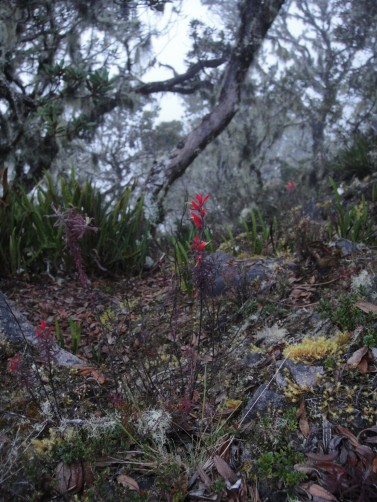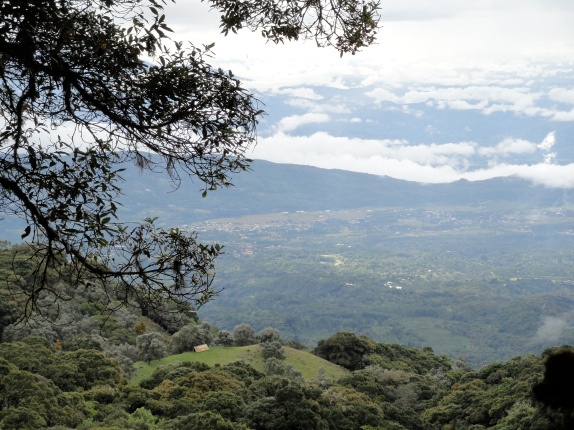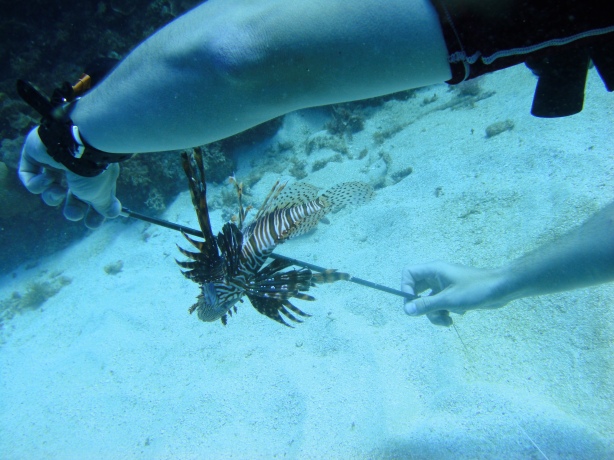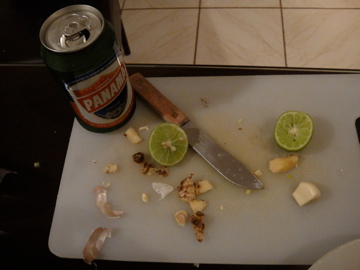Happy Thanksgiving everyone! Enjoy some turkey and pie for me, because, although we are having a Panamanian version of turkey day, we will be missing the bird, and also most of the traditional foods. But never fear, there will be plenty of wine and good company to go around. Anyway, the arrival of Thanksgiving made me think about what I am thankful for, and although I could probably write an entire blog post about things/people/opportunities that I am lucky to have in my life, nobody (except maybe my mom) wants to read that. So I figured I would write instead about my weekend getaway to Boquete. So obviously, as implied in the title, I decided to hike the tallest peak in Panama- Volcán Barú. Now before I get into the whole debacle, I should probably give a quick history of my idealist vision when it comes to hiking, especially long distances in Central America…
So once upon a time, I was traveling through Costa Rica, and I really really really wanted to hike through the rainforest, despite the fact that it was a guaranteed 4 day trip, while carrying all of the gear and food you need in 4 days on your back, PLUS it was going to be 90F the whole time. Piece of cake, right? So long story short this tragic hiking story begins with me passing out from dehydration just before entering the jungle. But never fear, I was fine, and insisted on continuing onward into the jungle. After the whole fainting in the forest thing, the rest of the day was fine, and then the next day we manage to hike 23 km, with only one or two incidents (me crying bc I thought we were lost, and also running from a hummingbird which I thought was a wild boar). Either way, I cannot move my legs at all the day after, and it is at this point, we decide that rather than torture ourselves any more we should probably just hitchhike our way out of the jungle by boat. Best. Decision. Ever. (SIDE NOTE: this story is way better when told in person, with a lot more drama and details, it’s a good one, but this is neither the time, nor the place).
Regardless, the Costa Rica Hiking Incident of 2008 merely demonstrates that I have this weird romantic idea about hiking, with a tendency to underestimate the pain and suckiness of a hike and overestimate my body’s ability. Now let’s fast forward almost 4 years. I have this grand idea that I want to hike the volcano in Panama (it’s extinct btw), why? Because it is the only place in the world where you can see the Pacific and the Atlantic oceans at once, from on top of a mountain…in the middle of a country. I think that pretty much explains everything. Nevermind that it’s 13.5 km (that’s 8.4 miles) to the summit, which means 27 km roundtrip (16.8 miles). Nevermind that the elevation change is 1600m (although some maps say 1900m, but for conservative math reasons, we’ll go with 1600, which is a mile). This means that in 8.4 miles, it’s a 1 mile ascent, which if you do the math, sucks. Nevermind all of that, because this is my romantic version of hiking, where the only thing that matters is the end result, not the actual hike itself.

Volcan Baru and Boquete town from a distance. Funny. It doesn't look that impressive from a distance.
So here’s how the whole thing goes down: Before I even went to Boquete, I had searched for a few tours that led hikes up the volcano. I found one were you hike up in the afternoon, make a campsite, and sleep overnight near the top, wake up the next morning, marvel at the sunrise, and hike back down. PERFECT. I love all of those things! I find out that in order to sign up there has to be 3 people total, I am alone, so I ask when the next group signed up is going, they tell me when, I plan my trip around this day because I want to do the overnight camping thing. Fine. Now when I actually get to Boquete, I head to the tour office and they tell me that the other people cancelled and that instead of an overnight hike it will just be during the day with a guide. Me and a guide. Alone. During the day. No sunrise. So I politely tell them that is not at all what I wanted, I get my refund, and go (there was a little more to it than this, but it doesn’t matter now, the point is I got out of the hike). Instead I join an overnight hike with six other people from my hostel, which leaves at 11:30pm, so that you are starting your hike at midnight, because it’s the early morning hours that you have the best chance to see the oceans, plus who wouldn’t want to see the sunrise from almost 3500m.
Now of course, the hike is overnight, so I tried to take a nap beforehand, since I got up at 6am that day to take care of my experiment before catching the 6 hr bus to Boquete, but it was too loud and I couldn’t nap. Fine, whatever, I’ll just hike for 10 hours overnight after already being awake for almost 18 hours, no big deal, this is Amber’s romantic dream world of hiking, and so a lack of sleep is no problem.
We begin the hike as a group, and after the first 5 minutes, we have already started to separate out into two groups: 4 in front (including me), and 3 in back. After 10 minutes of walking directly up hill, we are now 2 and 2 and the group of three is nowhere to be seen (or at least we cannot see their flashlight glow). After 20 minutes I am dying. Literally we have been walking up a gravel dirt road, directly uphill. My poor walking partner is French and super sweet, and has taken pity on me, and kept pace with me up until now but I can tell I am going to be holding him back. I insist that he should feel free to leave me behind at any time, he says no problem and stays with me. At 1am, we finally see the first distance marker sign: 2.5 km. I do the math, 2.5 km an hour, we’ll be at the top with plenty of time to spare before sunrise. Perfect. I am now soaking wet and disgusting. And I am steaming. Yes, it was COLD on the mountain, so I was steaming; at this point the temp was probably in the mid-50s, I could see my breath before I even started hiking, so it was colder than I have experienced in the last 7 months, but I am sweating like a mad-woman so I hardly notice the cold. As we approach the 3.5 km mark, the distance between me and my hiking partner grows, and eventually I can no longer see him, or his flashlight glow. And this is when the whole, ‘it’s more mental than physical’ thing kicks in. Have you ever hiked alone through the jungle, on a really strenuous trail, without getting any sleep, in the middle of the night with just a flashlight in a foreign country? Well let me tell you, all sorts of crazy things start going through your mind. All of the sudden, every twig snap, or weird sound makes you jump. And the fact that I was hiking 100 steps, and stopping to breathe was making me painfully aware that if there were any predators out there I would be by far the easiest thing to catch in the entire jungle (I later found out that there are mountain lions, so yeah, dodged a bullet there). The best part was that there were no distance markers between 4.5 km and 7.5km, which means that for an hour and a half (I was going a lot slower now) I saw nothing at all to give me encouragement.
It was around this time, marker 7.5 km, when I realized I was just over halfway done; I was miserable and sweaty and my legs hurt, and so I decided that maybe I should just turn around and go back down the trail and wait at the bottom. But knowing that it was almost 3am, and that if I just kept walking that in 2.5 hrs I would be at the top kept me going. Or maybe it was because I had passed a few sketchy looking dudes lurking on the trail and decided that it was best to keep moving rather than sit and wait for someone to machete me to death. Who knows, either way I kept walking, 50 steps at a time, then a rest. I think it was the slowest I have EVER walked in my life. Literally. It was around this time that my hip starting hurting. A lot. I have conveniently left out that I hurt my hip while running last week, I don’t really know what happened, I was running fine, then there was a shooting pain, and then I could no longer run. I was limping the whole next day. So I didn’t run the week before I left for Boquete, hoping it was just a pulled muscle and it would be fine. Well somewhere between 7.5km and 9km my hip started doing this weird popping thing. It HURT. I told myself that this was a good enough reason to head back down the mountain, and I could just hide in the bushes if sketchy dudes came and tried to machete me. But then, I decided that maybe I would just keep hiking until 9km, and see how I felt at that point. So I did, and miraculously at 9km the trail flattened out for the first time into a normal walkway, I daresay that it was pleasant. So I decided to keep going, the flat part ended about 200m after it began, but I discovered that if I stopped and sat on a rock for 5 min, my hip was ok enough to walk for a little while longer, so I did this for the next 4 km. It was a long 4 km, but at that point, I had convinced myself that turning around was not an option, and I had done the mental math and I knew that even at my molasses slow pace I would still make it to the top before the sunrise. Plus, if I knew that at the top, one of my hostel-mates had Aleve, so I figured I would persevere, despite the weird popping hip pain, and just take a bunch of Aleve for the walk down.
I FINALLY make it to the top….or what I think is the top, and see my fellow hostel hiker friends. They are all shaking with cold, literally, and I am still sweating like crazy with just my long sleeve shirt and undershirt on. I take 3 Aleve, and look around, noticing that this does not appear to be the top. They inform me that they were just waiting on me, and that we still have about a kilometer to go, so we start hiking, and it begins to get REALLY REALLY windy. Oh and it starts to rain. I should mention that the WHOLE hike the sky was completely clear, I could see every star in the sky including the milky way until about 4am, when it started to get cloudy. So by the time 530am rolled around, the entire summit was 100% socked in by clouds/fog. Awesome. I still held out hope that the sun would burn off the fog and we would get to see the oceans. Silly, silly me. Anyway, we hike up to the REAL summit, and wait for the sun to rise. It is now officially freezing. As in 32F at the top and WINDY. I put on a sweater over my gross sweaty clothes, and my raincoat, and was still cold. I put an extra pair on socks on my hands for gloves, and then huddled next to the radio station tower to block the wind. Oh yeah, funny thing- there were like 5 radio antennas, and a few giant buildings at the top, which made the whole thing kind of weird, since you just hiked up through 8.4 miles of jungle nothingness only to find all of this weird modern equipment at the top.

Some saint shrine thing at the summit. And no, that's not snow, its lichens.

This is the face of pure and absolute misery. I have never been so hideous in my life. Those bags under my eyes tell the tale of 28 hours of no sleep. I am at the summit and FREEZING. I took this picture to prove I was alive at the top. All I wanted to do was sleep and be warm. If I could have bought my way off the mountain at this point, I would have.

The Pacific Ocean. Or maybe the Atlantic. Doesn't matter, they all look the same when you are surrounded by clouds.

Pretty flower at the summit that distracted me from my pain.
I am now shaking, and cold, and miserable, and I cannot feel me hands or toes. The sun rises, and it slowly gets light out, but there is no ‘sunrise’ to see. And sadly, you could see nothing but fog/clouds in every direction, which means that I didn’t get to see the Atlantic and Pacific oceans. But at least I made it to the top, so theoretically I could have seen them…waaaay better than just giving up mid-way. I took a few pictures of the summit, waited for my friends to finish taking their pictures, and we hiked down. The hike down was actually more physically painful than the hike up, this time on the knees, imagine walking down stairs for 8.4 miles, because that’s pretty much what we did, except on boulders and rocks and gravel. In fact, as I walked down the endless hill at a really uncomfortable angle, I wondered how I even made it up to begin with. Maybe that’s why they tell you to hike up during the night. Because if you can only see the small amount of light in front of you, you won’t look up and realize that the trail never gets easier and just keeps going up at an unforgiving steepness. At least the walk down was pretty, the fog had created a really eerie mist over the whole mountain and everything was very Sleepy Hollow-esque.

A flat part of the trail, with the creepy fog and mossy tree.

The view of the valley on the walk down the volcano.
We finally reached the ranger’s station after only 3.5 hrs of hiking downhill, called a cab and went back to the hostel. I showered, and at 11am, was in bed. I literally could not properly move my legs the whole next day, but I guess it was worth it? If nothing else, at least I can say that I hiked it, and didn’t give up. And I wasn’t eaten by mountain lions, or machete’d to death, so for that, I am thankful.

Waiting for the cab to take me to my bed, after 10 hours of hiking, I am not excited right now.































